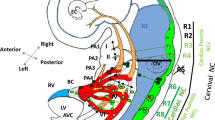Summary
The cardiac neural crest provides both ectomesenchyme and parasympathetic postganglionic neurons to the developing heart. Ablation of cardiac neural crest results in persistent truncus arteriosus, a condition in which the conotruncal and aorticopulmonary septa do not form in the developing heart. Parasympathetic postganglionic neurons are abundantly present in hearts with persistent truncus arteriosus, which indicates a “regeneration” of the neural component of the cardiac neural crest without comparable restitution of the ectomesenchymal component. The neural component has been shown to be provided by cells from the nodose placode following ablation of the cardiac neural crest. This investigation has shown that ectomesenchymal cells are also supplied to a limited extent by the nodose placode which normally has no ectomesenchymal derivatives. Although placode-derived ectomesenchyme helps to strengthen the wall of the cardiac outflow vessel, it is not competent to induce conotruncal and aorticopulmonary septal closure.
Similar content being viewed by others
References
Besson WT III, Kirby ML, Van Mierop LHS, Teabeaut JR II (1986) Effects of cardiac neural crest lesion size at various embryonic ages on incidence and types of cardiac defects. Circulation 73:360–364
Couly GF, Le Douarin NM (1985) Mapping of the early neural primordium in quail-chick chimeras. I. Developmental relationships between placodes, facial ectoderm, and prosencephalon. Dev Biol 110:422–439
d'Amico-Martel A, Noden DM (1983) Contributions of placodal and neural crest cells to avian cranial peripheral ganglia. Anat 166:445–4684
Feulgen R, Rossenbeck H (1924) Mikroskopisch-chemischer Nachweis einer Nucleinsäure vom Typus der Thymonucleinsäure und die darauf beruhende elektive Färbung von Zellkernen in mikroskopischen Präparaten. Hoppe-Seyler's Z Physiol Chem 135:203–248
Hamburger V, Hamilton H (1951) A series of normal stages in the development of the chick embryo. J. Morphol 88:49–92
Kirby ML (1987a) Cardiac morphogenesis: recent research advances. Ped Res 21:219–224
Kirby ML (1987b) Nodose placode contributes autonomic neurons to the heart in the absence of cardiac neural crest. J Neurosci (in press)
Kirby ML, Stewart DE (1983) Neural crest origin of cardiac ganglion cells in the chick embryo: identification and extirpation. Dev Biol 97:433–443
Kirby ML, Gale TF, Stewart DE (1983) Neural crest cells contribute to aorticopulmonary septation. Science 220:1059–1061
Kirby ML, Turnage KL, Hays BM (1985a) Characterization of conotruncal malformations following ablation of “cardiac” neural crest. Anat Rec 213:87–93
Kirby ML, Aronstam RS, Buccafusco JJ (1985b) Changes in cholinergic parameters associated with conotruncal malformations in embryonic chick heart. Circ Res 56:392–401
Le Liève CS, Le Douarin NM (1975) Mesenchyme derivatives of the neural crest: Analysis of chimeric quail and chick embryos. J Embryol Exp Morphol 34:125–154
Narayanan CH (1978) Apparatus and current techniques in the preparation of avian embryos for microsurgery and for observing embryonic behavior. Bioscience 20:868–871
Nishibatake M, Kirby ML, Van Mierop LHS (1987) Pathogenesis of persistent truncus arteriosus and dextroposed aorta in the chick embryo after neural crest ablation. Circulation 75:255
Phillips MT, Kirby ML, Forbes G (1987) Analysis of cranial neural crest distribution in the developing heart using quail-chick chimeras. Circ Rec 60:27–30
Thompson RP, Fitzharris TP (1979) Morphogenesis of the truncus arteriosus of the chick embryo heart: tissue reorganization during septation. Am J Anat 156:251–264
Wakley GK, Bower AJ (1981) The distal vagal ganglion of the hen (Gallus domesticus). A histological and physiological study. J Anat 132:95–115
Zacchei AM (1961) Lo sviluppo embrionale della quaglia giapponese (Coturnix coturnix japonica T. eS.). Arch Ital Anat Embryol 66:36–62
Author information
Authors and Affiliations
Rights and permissions
About this article
Cite this article
Kirby, M.L. Nodose placode provides ectomesenchyme to the developing chick heart in the absence of cardiac neural crest. Cell Tissue Res. 252, 17–22 (1988). https://doi.org/10.1007/BF00213821
Accepted:
Issue Date:
DOI: https://doi.org/10.1007/BF00213821




